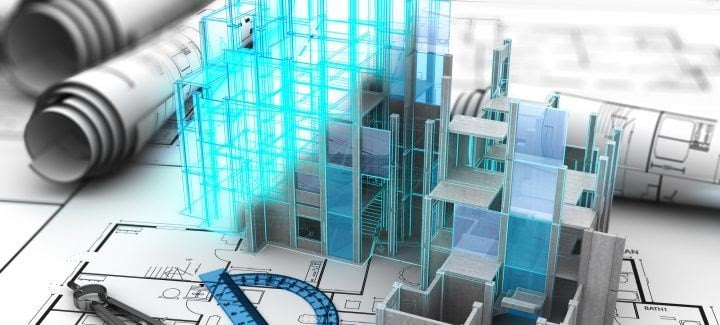
Building Information Modeling (BIM) has rapidly become a transformative force in the architecture and construction industry in the United States. Architects, engineers, and contractors increasingly rely on BIM softwares to streamline workflows, enhance collaboration, and improve project efficiency as projects grow in complexity and sustainability becomes a priority. The growth of BIM services created a new emphasis on digital transformation within the architecture along construction sectors.
Firms are leveraging BIM modeling and BIM software like Revit and ArchiCAD to improve design accuracy and facilitate seamless project coordination. Public infrastructure projects in various states of the USA now require builders to use BIM technology under mandatory requirements. The construction sector is undergoing an essential transformation toward different methods of designing, constructing and maintaining buildings.
What is BIM & Why is It Crucial for the Future of Architecture?
BIM is a digital process that allows professionals in BIM architecture and construction to create and manage BIM models representing buildings' physical and functional aspects. Unlike traditional 2D drafting, BIM modeling enables real-time collaboration, reducing errors and rework.
The future of architecture relies heavily on building information modeling because it provides improved design clarity and better sustainability. Through this technology, building professionals gain predictions about project costs. They can prevent design conflicts as well as maximise building performance. Designing through BIM enables construction projects to fulfill environmental demands by creating energy-saving, sustainable buildings.
Key Factors Driving BIM Adoption in the USA

Several factors contribute to the rising BIM adoption in the United States:
-
Government Regulations & Policies—Various state and federal agencies have mandated using BIM services for large-scale projects, driving widespread adoption.
-
Cost & Time Efficiency – BIM reduces construction costs by minimising material waste and preventing design errors before construction begins.
-
Technological Advancements – The availability of sophisticated BIM softwares like Autodesk Revit, ArchiCAD, and Bentley Systems has made adoption more straightforward for firms of all sizes.
-
Growing Demand for Collaboration – Integrated project delivery (IPD) and digital twin technologies require seamless coordination, which BIM modeling facilitates.
-
Sustainability Goals—As green certifications like LEED and WELL become industry standards, BIM helps in energy modeling and sustainable design strategies.
How BIM is Transforming Architectural Workflows

The integration of BIM and construction processes is revolutionising architectural workflows in several ways:
- Enhanced Design Accuracy – Architects can create detailed 3D BIM models, reducing design inconsistencies and conflicts between disciplines.
- Improved Collaboration – Cloud-based BIM services allow real-time sharing of designs, making collaboration between architects, engineers, and contractors seamless.
- Automated Workflows – Parametric design capabilities in BIM software automate repetitive tasks, increasing efficiency.
- Better Facility Management – BIM data extends beyond construction, aiding in the long-term maintenance and management of buildings.
Challenges in BIM Adoption Across the USA
Despite its benefits, BIM adoption faces several challenges in the US:
- High Initial Costs – Implementing BIM software requires significant training, licensing, and infrastructure investment.
- Resistance to Change – Traditional architectural firms may be hesitant to shift from 2D CAD to 3D BIM modeling due to lack of expertise or skepticism about ROI.
- Interoperability Issues – Different BIM software may have compatibility issues, complicating team data exchange.
- Need for Skilled Professionals – The demand for BIM specialists and trained professionals exceeds supply, creating a skill gap in the industry.
BIM Adoption Trends Across Different US States & Cities
BIM adoption varies across states and cities, with some regions leading the charge:
- California & New York – Due to stringent sustainability regulations, BIM and construction integration are most advanced in these states.
- Texas & Florida – Rapid urbanisation and large-scale infrastructure projects have accelerated BIM implementation.
- Chicago and Boston—The Universities and research institutions in these cities are at the forefront of BIM training and innovation.
- Seattle & San Francisco – Tech-driven cities have embraced BIM for innovative city projects and eco-friendly urban development.
Career Opportunities & Salary Trends for BIM Professionals in the USA
With increasing BIM adoption, the demand for skilled professionals is rising. Career opportunities include:
1. BIM Specialist
Experts who develop and manage BIM models for architecture and construction firms.
2. BIM Manager
Professionals oversee BIM implementation across projects.
3. BIM Coordinator
Individuals ensure seamless collaboration between project stakeholders using BIM software.
4. BIM Consultant
Specialists who guide firms in optimising their BIM services.
According to industry reports:
- The average salary for a BIM specialist in the US is around $94,029 per year, with a total pay range of $75K–$119K/yr.
- BIM managers earn between $90,816 annually, typically between $71,695 and $102,040.
- The demand for BIM jobs is expected to grow by 13% in the next five years, making it lucrative.
How Architects & Designers Can Upskill to Stay Competitive in the BIM Era
Professionals need to invest in BIM courses and practical training to remain competitive. Novatr is one of the best platforms for acquiring expertise through its specialised BIM training programs dedicated to architects and designers.
Why Choose Novatr for BIM Training?
Novatr’s Building Information Modelling for Architects by Novatr is one of the most recognised training programs available. This course is designed specifically for electrical technicians and engineers looking to master BIM MEP services and become industry-ready.
Course Highlights & USPs
- Industry-Relevant Courses – Designed by experts, covering advanced BIM modeling and real-world applications.
- Hands-On Learning – Practical experience with leading BIM softwares like Revit and Rhino.
- Placement Assistance – Connects learners with top firms for BIM jobs.
- Flexible Learning Options – Online and hybrid courses for working professionals.
Conclusion
The American building market selects BIM for architecture business transformation while advancing efficiency in design creation, team coordination and environmental sustainability. BIM is an indispensable tool for the architecture and construction sector due to its numerous advantages, surpassing the existing challenges. BIM specialists maintain their professional position in the industry because of increasing demand, yet they must upgrade their skills through BIM training and courses to meet industry requirements. To keep their position as competitive players in this changing market, architects, designers and engineers must embrace BIM as their design tool.
Building Information Modelling for Architects by Novatr is designed to help professionals and students seamlessly transition. This course bridges the gap between theory and implementation with industry-relevant tools, advanced BIM workflows, and mentorship delivered by experts. This curriculum provides the ideal basis for success, whether you're a student keen to specialise or an architect hoping to secure your job for the future.
Take the next step in your career today! Explore Novatr’s Resource Page for the latest industry insights and updates.
FAQs
Q1: What BIM software do architects in the USA prefer for their projects?
Ans: US architectural firms primarily implement three BIM software solutions, Autodesk Revit, ArchiCAD, and Bentley Systems, for their building implementations. These tools create BIM models, providing BIM services while enhancing design and construction team coordination. Software selection depends on project complexity levels, team member distribution numbers, and required interoperability standards.
Q2: How can architects and engineers upskill for BIM jobs in the USA?
Ans: BIM courses from Novatr allow professionals to improve their skills and learn useful BIM modeling and project implementation techniques. Combining BIM software expertise with advanced BIM training programs generates additional employment prospects that significantly increase architecture professionals' compensation opportunities.
Q3: How do BIM models help in reducing construction errors and delays?
Ans: BIM models' real-time clash detection capability helps identify structural, MEP, and architectural elements that do not intersect. The adoption of BIM systems enables early identification of project issues, minimising building mistakes, reducing retrofit work, and shortening construction periods to enhance project operational productivity.
Was this content helpful to you



.jpeg)







